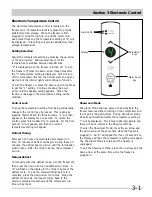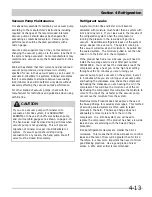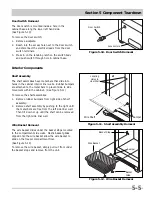
Section 4 Refrigeration
4-11
Verify Refrigerant Type In The System
Dedicated Equipment
R-134a must not be mixed with other types of
refrigerants. R-134a must be recovered in dedicated
and properly identified recovery bags and tanks.
It will be necessary to check with the manufacturer of
your recovery equipment to determine R-134a
compatibility. Some recovery equipment manufacturers
have changeover instructions for switching between
refrigerant types. Protect yourself and your equipment
by following all manufacturer guidelines.
Also, ensure that your refrigeration hoses are specified
for use with R-134a refrigerant. Research has shown
that compounds in standard refrigeration hoses may
enter sealed systems and ultimately restrict the cap tube
in an R-134a system.
R-134a Refrigeration Systems
The sealed refrigeration system will consist of the same
basic components being utilized in the R-12 systems.
There is a 10% to 15% discharge pressure increase
using R-134a, with a 5% to 10% decrease in suction
pressure when compared to the same product with an
R-12 system operating at 90°F (32°C) ambient
temperature conditions. Lower suction pressures result
from the lower density of R-134a refrigerant which
effects refrigerant flow rate. R-134a systems commonly
operate in a 1”-2” vacuum on the suction side.
Products using R-134a refrigerant will generally have a
longer capillary tube to maintain a similar flow rate and
some models will have a larger condenser to reduce the
discharge pressures and lower start-up sound
transmission.
Miscibility of R-134a and Ester Oil
A special synthetic oil known as Ester oil is used as a
lubricant in refrigeration systems operating on R-134a.
Ester oils are produced from alcohols and fatty acids and
are available in several different variants. Ester oils have
a pleasant aroma reminiscent of fruit.
Ester oils generally include various types of additives for
improving certain properties such as viscosity,
temperature sensitivity, etc. These additives are often
aggressive, and skin contact with Ester oils should
therefore be avoided.
One of the most important requirements made on a
refrigerant system is that the oil mix with the refrigerant.
Since mineral oil and ordinary synthetic oil DO NOT mix
with R-134a, Ester oil is used for lubrication. Ester oil
dissolves in R-134a.
Ester oil is broken down by chlorine and cannot be
used with R-12 (R-12 contains chlorine) or any other
compound containing chlorine. Therefore, R-134a
refrigeration systems have virtually no tolerance for
chlorine molecules from CFC refrigerants (R-134a is an
HFC and contains no chlorine).
During R-134a service, it is extremely important to
avoid using equipment that may contain residual
amounts of mineral oil, CFC’s or HCFC’s which could
enter and contaminate the sealed system.
CAUTION
R-134a and R-12 are completely incompatible. Before
starting any sealed system repair, it is extremely
important to check serial plate of product to verify the
type of refrigerant in the system.
CAUTION
The following instructions are generalized to help the
technician understand the procedures of sealed
system repairs. See Section 5 Component Teardown
on the exact steps of accessing the components of
the refrigeration system.
NOTE
Summary of Contents for FFH17F8HW0
Page 2: ......
Page 14: ...Section 2 Installation Information 2 6 Notes ...
Page 18: ...Section 3 Electronic Control 3 4 Notes ...
Page 33: ...Section 4 Refrigeration 4 15 HFC 134a CFC 12 Pressure Temperature Chart ...
Page 36: ...Section 4 Refrigeration 4 18 Notes ...
Page 48: ...Section 5 Component Teardown 5 12 Notes ...
Page 53: ...Section 7 Wiring Diagram 7 1 ...
















































